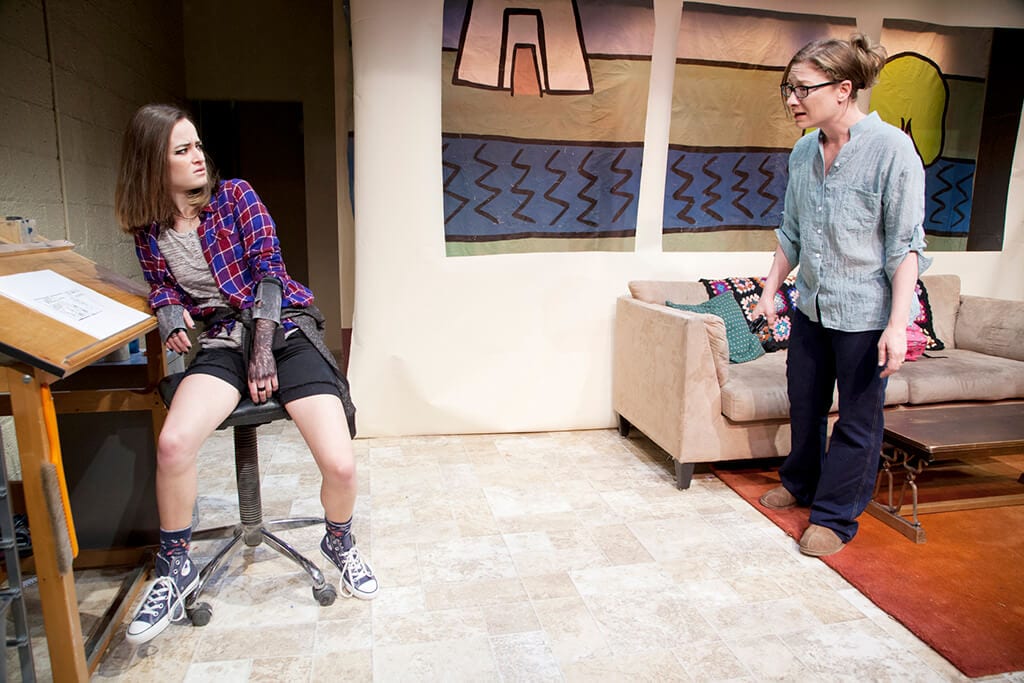They say that introducing a major change is what makes a good story, and The Tomb of King Tot certainly masters this trick. We’re just getting comfortable with the characters – each quirky and instantly likeable in their own way – when the show plunges with a tragic twist, leaving the characters reeling and sending the audience on an unexpected journey.
We enter the world of dedicated and painfully punny cartoonist Jane (Annie McNamara) through her comic strips: life-size and neatly packed into three panels. The strips feature King Tot, the nine-year-old Pharaoh, and Horemheb, Tot’s slave-slash-friend, who act out their antics while Jane chuckles delightedly over her drawing board. Her strips are even good enough that she is poised to receive a comically small award (for the best cartoonist in “all of eastern New England!”) which means the world to Jane. But Jane’s world is soon turned upside down, and King Tot and Horemheb – caricatures of her stingy daughter Atlanta (Bianca Crudo) and her husband Porter (Nick Choksi), respectively – take on much darker and more meaningful personas, escaping the confines of the three-panel setup and taking over Jane’s mind entirely.
Before we know what hit us, the audience is hurled into a psychedelic world of coping with grief. Dufault’s play alternates expertly between reality and the imaginary Egypt of King Tot, between laugh-out-loud humor and tragedy. When Jane is delivered the news that her daughter is gone, she focuses with an unfeeling, maniacal drive on her nomination for the cartoonists’ award. She immerses herself in her own cartoon world come to life. King Tot, a reincarnation of her daughter, and Horemheb emerge from behind the three-panel screen and become three-dimensional. Rather than hunching over her drawing board, Jane sits among them as an invisible observer, no longer dictating their moves but watching them with an inexplicable urgency. With them and through them, she grapples with the concepts of death and responsibility.
Bianca Crudo’s King Tot is the keystone of Jane’s search for closure, and Crudo delivers a captivating performance. I found myself on the edge of my seat at King Tot’s every word. In fact, the performances by the whole cast were touching and sincere, carving out a wholly believable world with truly sympathetic characters and real grief.
Watching Jane explore unimaginable loss through her art is heartbreaking and compelling. Our empathy for Jane is heightened all the more as we switch back and forth between her cartoons and her life, where we see she is in a state of total denial. Also peppering the plot are appearances from Porter, who alternates between Jane’s husband and Horemheb the cartoon, as well as Jane’s rival cartoonist Kissy Candida (Carmen M. Herlihy), who makes a hilariously creepy transformation from comic-strip-worthy arch nemesis to a heart-devouring Egyptian crocodile goddess.
Grief is the utterly relatable tone of this play, but not in a doomed, Greek-tragedy sort of way. Instead, King Tot explores loss and how people deal with death, from Jane’s bottled emotions to her goofy, well-meaning husband, often seen guzzling a bottle of wine from the stress of having to make all the difficult, practical decisions that come with death. The Tomb of King Tot is a glimpse into the intimate lives of a few people bound together by sorrow and the high-stakes competition of cartooning in eastern New England: full of humor, fantasy, and ultimately closure of the sweetest kind.

